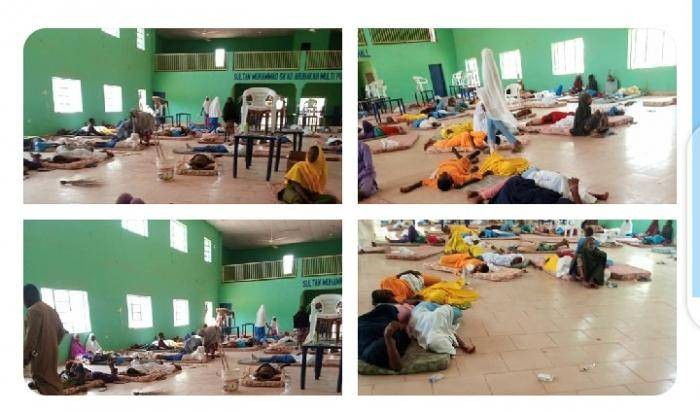
All secondary schools in Nigeria operate with a scheme of work. The scheme of work is a guideline that defines the contents and structure of academic subjects. The scheme of work for secondary schools in Nigeria, whether Junior or Senior secondary school, maps out in clear terms, how resources, for example, the topics and subtopics for a particular subject, teacher-talk, group work, practical, discussions and assessment strategies, tests, quizzes, Questions and Answers, homework and even up to midterm breaks for the session ought to be structured in order to fit in perfectly for the academic session.
This is the complete guide on all academic activities enforced by the Federal government of Nigeria through the various states ministry of education on all Senior Secondary Schools in Nigeria as it relates not just to the subjects but the academic session as a whole. It is used to ensure that the learning purposes, aims and objectives of the subject meant for that class are successfully achieved.
Every academic session, academicians from the federal and state ministry of education come to a round table to discuss on the needed updates on the unified scheme of work for secondary schools in Nigeria. It is termed unified because all schools in Nigeria and western Africa make use of the same scheme of work. It is the reason West African Senior Secondary Certificate Examination (WASSCE) results is accepted throughout Western Africa.
Scheme of work for Senior Secondary Schools in Nigeria are practically the same for both private and public secondary schools in Nigeria ranging from SS 1 to SS 3, that is, the scheme of work for a private school is the same with that of public or government owned secondary schools, principals and teachers in secondary schools in Nigeria are to adhere to the approved scheme of work as mandated by the ministry of education.
Take for instance, the scheme of work for Senior Secondary Schools in Nigeria say from SS 1 to SS 3 for all subjects whether it is Mathematics, English Language, Computer Science, physics, chemistry, biology, technical drawing and other subjects offered in senior secondary schools in Nigeria are the same irrespective of the state the school is sited.
This post is quite a lengthy one as it provide in full details, the government approved unified scheme of work for all subjects offered in Senior Secondary Schools in Nigeria. If you are interested in starting a school in Nigeria, this would greatly help in guiding you as regards coming up with the approved scheme of work for any subject offered in SS 1, SS 2 and SS 3.
Please note that these scheme of work are the approved by Lagos state government and other state government in Nigeria.
What You Stand To Gain From This Post
- Government approved Scheme of work for Senior Secondary school Mathematics – (SS 1, SS 2 and SS 3)
- The government approved Scheme of work for Physics – (SS 1, SS 2 and SS3)
- The government approved Scheme of work for English Language – SS 1, SS 2 & SS 3
- The government approved Scheme of work for Agricultural Science – SS 1, SS 2 and SS 3)
- The government approved Scheme of work for Biology – (SS 1, SS 2 and SS 3)
- Approved Scheme of work for Civic Education – (SS 1, SS 2 and SS 3)
- Scheme of work for Food and Nutrition – (SS 1, SS 2 and SS 3)
- Scheme of work for Chemistry – (SS 1, SS 2 and SS 3)
- Scheme of work for Further Mathematics – (SS 1, SS 2 and SS 3)
- Scheme of work for Computer Science – (SS 1, SS 2 and SS 3)
- Scheme of work for Government – (SS 1, SS 2 and SS 3)
⇒ Get your updated Unified Lesson Notes for All Subjects 2024 Price Per Note N900 – Call or WhatsApp 07062541362
Government Approved Scheme of Work For Senior Secondary School SS 1 to SS3
Below contains the unified scheme of work for all subjects offered in Junior and senior secondary schools in Nigeria. Please note that some subjects in this post have been added via downloadable links in PDF format. This will enable you have the scheme right on your personal devices.
SCHEME OF WORK FOR CIVIC EDUCATION SS 3 FIRST TERM and SECOND TERM
- Our Values
- Emerging Issues
- Citizenship
- Representative Democracy
- Pillars of Democracy
- Human Rights
- Law and Order
- Cultism
- Citizenship
- Democracy and National Development
- Dangers of Political Apathy
Second Term Scheme of Work for Civic Education for SS 3
- Achieving Popular Participation in Polities
- Limitation of Human Rights
- Drugs and Drug Abuse
- Responsible Parenthood
- Traffic Regulations
- Relationships
- Characteristics of Human Rights
- Dangers of Political Apathy II
- Public Service in a Democracy
- Civic Society and Popular Participation
- Constitutional Democracy
SCHEME OF WORK FOR CIVIC EDUCATION SS 1 FIRST TERM
WEEK 1: Definition of Civic Education
WEEK 2: Values: Definition And Types
WEEK 3: Moral Values
WEEK 4: Self Defense
WEEK 5: Community Service
WEEK 6: HIV/Aids Continues
WEEK 7: HIV/Aids Continues
WEEK 8: Youth Empowerment
WEEK 9 & 10: Importance of Skill Acquisition
WEEK 11: Revision
WEEK 12: Examination and Closing for the Term
SCHEME OF WORK FOR CIVIC EDUCATION SS 1 SECOND TERM
WEEK 1: Revision of Last Term’s Work
WEEK 2 & 3: The Structure Of Government
WEEK 4 & 6: Law And Order
WEEK 7: Democracy: Definition And Types
WEEK 8: Pillars Of Democracy I.E Constitution, Rule of Law Etc.
WEEK 9 & 10: Nationalism
WEEK 11: United Nation Declaration Of Human Rights
WEEK 12: Types Of Human Rights
WEEK 13: Examination and Closing for the Term
SCHEME OF WORK FOR CIVIC EDUCATION SS 1 THIRD TERM
WEEK 1: Revision of Last Term’s Work
WEEK 2: Cultism – Origin
WEEK 3: Cultism in Higher Institutions of Higher learning in Nigeria
WEEK 4: Consequences of Cultism
WEEK 5 & 6: Constituted Authority
WEEK 7 & 8:. Respect for Constituted Authority
WEEK 9 & 10: Emergence of Leadership
WEEK 11: Importance of Constituted Authority
WEEK 12: Examination and Closing for the Term
SCHEME OF WORK FOR MATHEMATICS SS 3 FIRST TERM
WEEK 1: Surds
WEEK 2: Matrics and Determinants
WEEK 3: Logarithm (Revision)
WEEK 4: Commercial Arithmetic
WEEK 11: Simultaneous, Linear and Quadratic Equation (Revision)
SCHEME OF WORK FOR MATHEMATICS SS 3 SECOND TERM
WEEK 1: Trigonometric Graph of Trigonometric Ratios
WEEK 2: Graphical Solution of Simultaneous Linear and Trigonometric Equations
WEEK 3: Surface Area of Sphere
WEEK 4: Volume of Sphere
WEEK 5: Longitude and Latitude
WEEK 6: Coordinate Geometry of Straight Lines
WEEK 7: Gradients and Intercept of a Straight Line
WEEK 8: Differentiation of Algebraic Fractions
WEEK 9: Integration of Simple Algebraic Functions
WEEK 10: Arc Length of a Curve
SCHEME OF WORK FOR MATHEMATICS SS 1 FIRST TERM
- NUMBER BASE SYSTEM: Conversion from one base to base 10, conversion of decimal fraction to base 10, conversion of number from one base to another 11 base. Addition, subtraction, multiplication and division of number bases.
- MODULAR ARITHMETIC:
Definition and concept of module arithmetic: Addition, subtraction and multiplication of module arithmetic and applying it to solving life problem. - INDICES: Conversion of numbers to standard form; laws of indices, indicial equations.
- LOGARITHMS AND INDICES:
Definition of logarithm; logarithm of numbers in base 10, expressing logarithm as inverse of Indices, Graph of Y = 10x, logarithm and anti-logarithms tables of numbers greater than one, laws of logarithms – multiplication, division, powers and roots. - SET: Definition of set, set notation, types of sets, set operation, use of Venn diagrams.
- SIMPLE EQUATIONS AND VARIATIONS: Change of subject of formulae involving bracket, root and
powers. Types of variation – direct, inverse, joint and partial. - QUADRATIC EQUATION: Factorization, completing the square, formulae and graphical method and obtaining roots from quadratic graphs.
- LOGICAL REASONING: Simple and compound statements.
SCHEME OF WORK FOR MATHEMATICS SS 1 SECOND TERM
CONSTRUCTION OF ANGLES 30, 45, 60, 90 e.t.c .
Triangles, Equivalent angles, Equidistance from 2 points, 2 lines, fixed point and 4 – sides plane figure given certain conditions, locus of given points.
1. PROOFS OF SOME BASIC THEOREMS IN EUDIDEAN GEOMETRY:
Angle sum of a triangle is 180 degree, the exterior angle of a triangle is equal to the sum of two interior opposite angles.
3. RIDERS: Proofs of properties of Angles on parallel lines, Angles in a polygon, Congruent angles, Parallelograms and intercept theorem.
- TRIGONOMETRIC RATIOS: Sine, cosine and tangent with reference to right angled triangles.
- TRIGONOMETRY: Derivation of Trigonometric ratios of 30 degrees, 45 degrees and 60 degrees from drawn angles.
- TRIGONOMETRY: Angle of elevation and depression and application of trigonometric ratios.
- TRIGONOMETRIC RATIOS: In relation to unit circle, Sine and Cosine of various angles.
- GRAPH OF SINES AND COSINES USING 15 degrees, 20 degrees, 30 degrees, 60 degrees etc.
- LENGTH OF ARC OF CIRCLE
SCHEME OF WORK FOR MATHEMATICS SS 1 THIRD TERM
- Perimeters of sectors and segments
- Areas of Sectors of a Circle
- Areas of Segments of a Circle
- Relation between the sector of Circle and the surface of a Cone.
- Surface Area and Volume of Shapes – Cube, Cuboid, Cylinder, Pyramids, Cone, and Prism.
- Surface Area and Volume of fraction of Cones and Pyramids.
- Surface Area and Volume of Compound Shapes.
- Data Presentation and frequency distribution tables.
- Linear graph, Bar chart and Histograms: Differences between Bar charts and Histograms
- Pie chart and frequency polygon.
SCHEME OF WORK FOR MATHEMATICS SS 2 FIRST TERM
- Logarithms
- Approximations and Accuracy
- Sequences and series
- Quadratic equations
- Simultaneous, linear and Quadratic Equations
- Gradient of a curve and lines
SCHEME OF WORK FOR MATHEMATICS SS 2 SECOND TERM
- Logical Reasoning
- Determining Gradient of a curve by graph reading
- Linear Inequalities
- Algebraic Fractions
- Chord property (Circle geometry I)
- Circle theorems (Circle geometry II)
- Trigonometry (Derivation of Sine rule)
SCHEME OF WORK FOR MATHEMATICS SS 2 THIRD TERM
- Trigonometry (Derivation of Cosine rule)
- Trigonometric Ratios (revision) and Angles of elevation and depression
- Bearings
- Statistics (grouped data)
- Probability
SCHEME OF WORK FOR BIOLOGY SS 3 FIRST TERM
Week 1: Regulation of the Internal Environment
Week 2: Hormones
Week 3: Reproduction in Man
Week 4: Reproduction in Flowering Plants
Week 5: Fruits and seeds
Week 6: Genetics
Week 7: Reproductive Behaviors in Animals
Week 8: Evolution
SCHEME OF WORK FOR BIOLOGY SS 2 FIRST TERM
- Food Production and Storage
- Micro-Organisms in action
- Towards better health
- Aquatic Habitats
- Terrestrial Habitats
SCHEME OF WORK FOR BIOLOGY SS 2 SECOND TERM
- Terrestrial Habitat
- Reproduction in unicellular organisms and invertebrates
- Classification of plants
- Digestive system
- Transport system
- Respiratory system
- Excretory system
SCHEME OF WORK FOR BIOLOGY SS 2 THIRD TERM
- Excretory Mechanism
- Nutrient Cycling in Nature
- Ecological management
- Adaptation
- Pollution
SCHEME OF WORK FOR CIVIC EDUCATION SS 3 FIRST TERM and SECOND TERM
- Our Values
- Emerging Issues
- Citizenship
- Representative Democracy
- Pillars of Democracy
- Human Rights
- Law and Order
- Cultism
- Citizenship
- Democracy and National Development
- Dangers of Political Apathy
- Achieving Popular Participation in Polities
- Limitation of Human Rights
- Drugs and Drug Abuse
- Responsible Parenthood
- Traffic Regulations
- Relationships
- Characteristics of Human Rights
- Dangers of Political Apathy II
- Public Service in a Democracy
- Civic Society and Popular Participation
- Constitutional Democracy
SCHEME OF WORK FOR PHYSICS SS 1 FIRST TERM
- Meaning of Physics: Physical quantities and units of quantities
- Measuring of instruments
- Concepts of position and motion
- Speed velocity and acceleration
- Displacement and velocity – time graphs
- Circular motion
- Friction
- Density and relative density
SCHEME OF WORK FOR PHYSICS SS 1 SECOND TERM
- Work, energy and power
- Concepts of heat and temperature
- Measurement of temperature
- Thermal expansion of solids
- Transmission of heat
SCHEME OF WORK FOR PHYSICS SS 1 THIRD TERM
- Electric charges and static electricity
- Description and properties of fields
- Introduction to current electricity
- Ohm’s law, resistors in circuits, electrical energy and power
- Elastic properties of solids
- Molecular properties and forces; adhesion and cohesion
- Surface tension and viscous forces
- Crystalline nature of solids
- Industrial units (Technological applications of Physics)
SCHEME OF WORK FOR PHYSICS SS 2 FIRST TERM
- Force momentum and Newton’s laws of motion
- Application of Newton’s laws’ resultant forces and acceleration.
- Simple machines
- Pressures in fluids
- Heat capacity
- Latent heats
- Practical effects of state changes: Melting, evaporation, vapour pressures, boiling and humidity.
- Expansion of Gases and gas laws
SCHEME OF WORK FOR PHYSICS SS 2 SECOND TERM
- The concepts of position and distance in coordinate systems.
- Vectors
- Uniformly Accelerated motion
- Projectiles
- Basics concepts of simple harmonic motion (S.H.M.)
- Applications of simple Harmonic motion
- Force and equilibrium of particles/concurrent forces
- Equilibrium of rigid / coplanar forces centre of gravity and stability
- Equilibrium of bodies in fluids – upthrust, Archetypes and flotation principles
SCHEME OF WORK FOR PHYSICS SS 2 THIRD TERM
- Rectilinear propagation of light and reflection of light at plane surface
- Reflection by curved mirrors
- Refraction of light at plane boundaries
- Refraction and image formation by lenses
- Technological application of lenses: Optical instruments
- Basic concepts and propagation of wave motion
- Musical sounds: Waves in string and pipes
- The wave equation: Physical properties of waves.
SCHEME OF WORK FOR PHYSICS SS 3 FIRST TERM
- The electromagnetic spectrum and dispersion of light
- Gravitational fields
- Electrostatic fields; capacitors
- Direct current circuits, resistance and resistivity
- Electro-chemical cells, E.M.F, internal resistance and circuits
- Principles of electrical measurations (shunts, multipliers, bridge circuits)
- Electrical work, energy and power; cost.
- Conduction of electricity through liquids (electrolysis)
- Magnetism and magnetic fields
- Electromagnetic induction
SCHEME OF WORK FOR PHYSICS SS 3 SECOND TERM
- Alternating current (a.c) circuits
- Atomic models, atomic spectra and the uncertainty principle
- Gas-tube electronics; electronic emissions and their applications.
- Semi-conductor electronics
- Radio-activity
- Technological applications of Physics (1); Uses of machines, power transmission in mechanical systems, maintenance.
- Technological applications of Physics (2); Energy, dams, power stations, satellites in Nigeria.
SCHEME OF WORK FOR CHEMISTRY SS 1 FIRST TERM
- Introduction to chemistry
- Chemical industries
- Atoms molecules, atomiuty
- Physical and chemical changes
- Electronic configuration
- Relative utomic molecular
- Atomic mars/atomic number
- Chemical symbol
- Chemical equation
- Empirical formular
- Molecular formular
- Chemical examination
- Chemical laws
SCHEME OF WORK FOR CHEMISTRY SS 1 SECOND TERM
- Knetic theory of matter
- Gas laws
i) Boyle’s law
ii) Charles law
iii) Combined gas law
iv) Gay Lussa’s law
v) Avogadro’s law - Septanut on techniques
- Acids, basis and salt
SCHEME OF WORK FOR CHEMISTRY SS 1 THIRD TERM
- Water
- Carbon and its compounds
- Formation of coal:
- Destructive distillation of coal
- Uses of coal
- Properties of carbon
- Oxides of carbon
i) Carbon cycle - Synthetic gas
a) Carbonaceous
b) Tiorxocarbenates (iv) acid
c) Tiroxrocaronata iv - Hydrocarbons
a) Crude oil and natural gas
SCHEME OF WORK FOR CHEMISTRY SS 2 FIRST TERM
WEEK 1 Periodic Table
WEEK 2 & 3 Oxidation and Reduction Reactions
WEEK 4 & 5 Mass-Volume Relationship
WEEK 6 Electrolysis
WEEK 7 Electrode Potential
WEEK 8 Acid-Base Reactions
WEEK 9 Rates of Chemical Reaction
WEEK 10 Energy and Chemical Reactions
SCHEME OF WORK FOR CHEMISTRY SS 2 SECOND TERM
WEEK 1 Chemical Equilibrium
WEEK 2 Hydrogen Gas
WEEK 3 Oxygen Gas
WEEK 4 & 5 Chlorine and its Compounds
WEEK 6 & 7 Nitrogen and its Compounds
WEEK 8 & 9 Sulphur and its Compounds
SCHEME OF WORK FOR CHEMISTRY SS 2 THIRD TERM
WEEK 1 & 2 Water and Solutions
WEEK 3 Hardness of water
WEEK 4 & 5 Sulphur and its Compounds
WEEK 6 – 7 Organic Chemistry (Hydrocarbons)
WEEK 8 Benzene and its Compound
WEEK 9 Alkanols
SCHEME OF WORK FOR CHEMISTRY SS 3 FIRST TERM
WEEK 1 & 2 Atomic Structure
WEEK 3 Nuclear Chemistry
WEEK 4, 5 & 6 Metals and their compounds
WEEK 7 & 8 Organic Chemistry 2
SCHEME OF WORK FOR CHEMISTRY SS 3 SECOND TERM
WEEK 1 Revision of Non-metals and their
compounds
WEEK 2 Revision of Organic Chemistry I
WEEK 3 Revision of Organic Chemistry 2
WEEK 4 Revision of Periodic table
WEEK 5 Revision of Mass-volume Relationship
WEEK 6 Acid-Base Titration Calculations
WEEK 7 Salt analysis (qualitative analysis)
Scheme of Work for Building Construction SSI – SS3 1st, 2nd & 3rd Term
Click to download the Unified Scheme of Work for Building Construction – PDF
Scheme of Work for Clothing and Textiles SSI – SS3 1st, 2nd & 3rd Term
Click to download Unified Scheme of work for Clothing and Textiles – PDF
The scheme of work published on this post is so far the most complete scheme of work for all subjects offered in senior secondary schools in Nigeria as at today. They are the government approved scheme of work compulsorily applicable in all post primary schools in West Africa because of WAEC and NECO examination.
We have painstakingly done our research, visited schools and the ministry of education to gather this information just for you. Kindly share via social media for others so they could benefit from it too. Do you have any questions? if you do, your can reach us via the comment section below and we shall respond as fast as possible.




